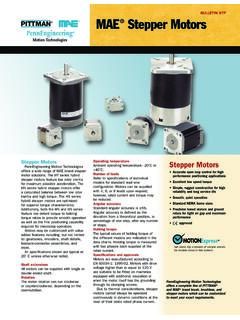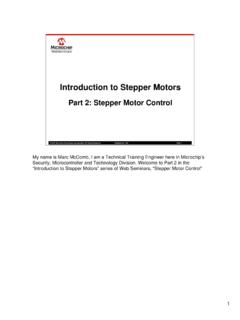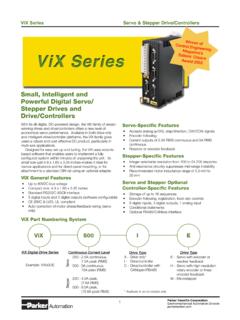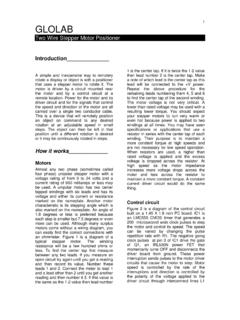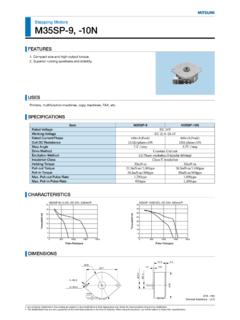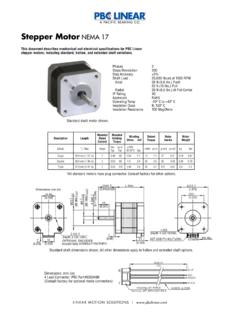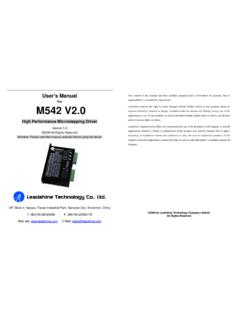Transcription of Stepping Motors Fundamentals
1 AN907. Stepping Motors Fundamentals Author: Reston Condit TYPES OF Stepping Motors . Microchip Technology Inc. There are three basic types of Stepping Motors : Dr. Douglas W. Jones permanent magnet, variable reluctance and hybrid. University of Iowa This application note covers all three types. Permanent magnet Motors have a magnetized rotor, while variable reluctance Motors have toothed soft-iron rotors. Hybrid INTRODUCTION Stepping Motors combine aspects of both permanent Stepping Motors fill a unique niche in the motor control magnet and variable reluctance technology.
2 World. These Motors are commonly used in measure- The stator, or stationary part of the Stepping motor ment and control applications. Sample applications holds multiple windings. The arrangement of these include ink jet printers, CNC machines and volumetric windings is the primary factor that distinguishes pumps. Several features common to all stepper Motors different types of Stepping Motors from an electrical make them ideally suited for these types of point of view. From the electrical and control system applications.
3 These features are as follows: perspective, variable reluctance Motors are distant 1. Brushless Stepper Motors are brushless. The from the other types. Both permanent magnet and commutator and brushes of conventional hybrid Motors may be wound using either unipolar Motors are some of the most failure-prone windings, bipolar windings or bifilar windings. Each of components, and they create electrical arcs that these is described in the sections below. are undesirable or dangerous in some environments.
4 Variable Reluctance Motors 2. Load Independent Stepper Motors will turn at Variable Reluctance Motors (also called variable a set speed regardless of load as long as the switched reluctance Motors ) have three to five load does not exceed the torque rating for the windings connected to a common terminal. Figure 1. motor . shows the cross section of a three winding, 30 degree 3. Open Loop Positioning Stepper Motors per step variable reluctance motor . The rotor in this move in quantified increments or steps.
5 As long motor has four teeth and the stator has six poles, with as the motor runs within its torque specification, each winding wrapped around opposing poles. The the position of the shaft is known at all times rotor teeth marked X are attracted to winding 1 when it without the need for a feedback mechanism. is energized. This attraction is caused by the magnetic 4. Holding Torque Stepper Motors are able to flux path generated around the coil and the rotor. The hold the shaft stationary. rotor experiences a torque and moves the rotor in line 5.
6 Excellent response to start-up, stopping and with the energized coils, minimizing the flux path. The reverse. motor moves clockwise when winding 1 is turned off and winding 2 in energized. The rotor teeth marked Y. The following sections discuss the most common types are attracted to winding 2. This results in 30 degrees of of stepper Motors , what circuitry is needed to drive clockwise motion as Y lines up with winding 2. these Motors , and how to control Stepping Motors with Continuous clockwise motion is achieved by sequen- a microcontroller.
7 Tially energizing and de-energizing windings around the stator. The following control sequence will spin the motor depicted in Figure 1 clockwise for 12 steps or one revolution. EXAMPLE 1: Winding 1: 1001001001001. Winding 2: 0100100100100. Winding 3: 0010010010010. time 2004 Microchip Technology Inc. DS00907A-page 1. AN907. Figure 1 illustrates the most basic variable reluctance FIGURE 2: UNIPOLAR STEPPER. Stepping motor . In practice, these Motors typically have motor . more winding poles and teeth for smaller step angles.
8 The number of poles can be made greater by adding windings, for example, moving to 4 or 5 windings, but for small step angles, the usual solution is to use toothed pole pieces working against a toothed rotor. Variable reluctance Motors using this approach are available with step angles close to one degree. FIGURE 1: VARIABLE RELUCTANCE. STEPPER motor . The difference between a permanent magnet Stepping motor and a hybrid Stepping motor lies in how the multi- pole rotor and multi-pole stator are constructed.
9 These differences will be discussed later. EXAMPLE 2: Winding 1a: 100010001000. Winding 1b: 001000100010. Unipolar Motors Winding 2a: 010001000100. Unipolar Stepping Motors are composed of two Winding 2b: 000100010001. windings, each with a center tap. The center taps are time either brought outside the motor as two separate wires (as shown in Figure 2) or connected to each other internally and brought outside the motor as one wire. As a result, unipolar Motors have 5 or 6 wires. Regard- Note: Only half of each winding is energized at a less of the number of wires, unipolar Motors are driven time in the above sequence.
10 As above, the in the same way. The center tap wire(s) is tied to a following sequence will spin the motor power supply and the ends of the coils are alternately clockwise 12 steps or one revolution. grounded. Unipolar Stepping Motors , like all permanent magnet EXAMPLE 3: and hybrid Motors , operate differently from variable reluctance Motors . Rather than operating by minimiz- Winding 1a: 110011001100. ing the length of the flux path between the stator poles Winding 1b: 001100110011. and the rotor teeth, where the direction of current flow Winding 2a: 011001100110.










